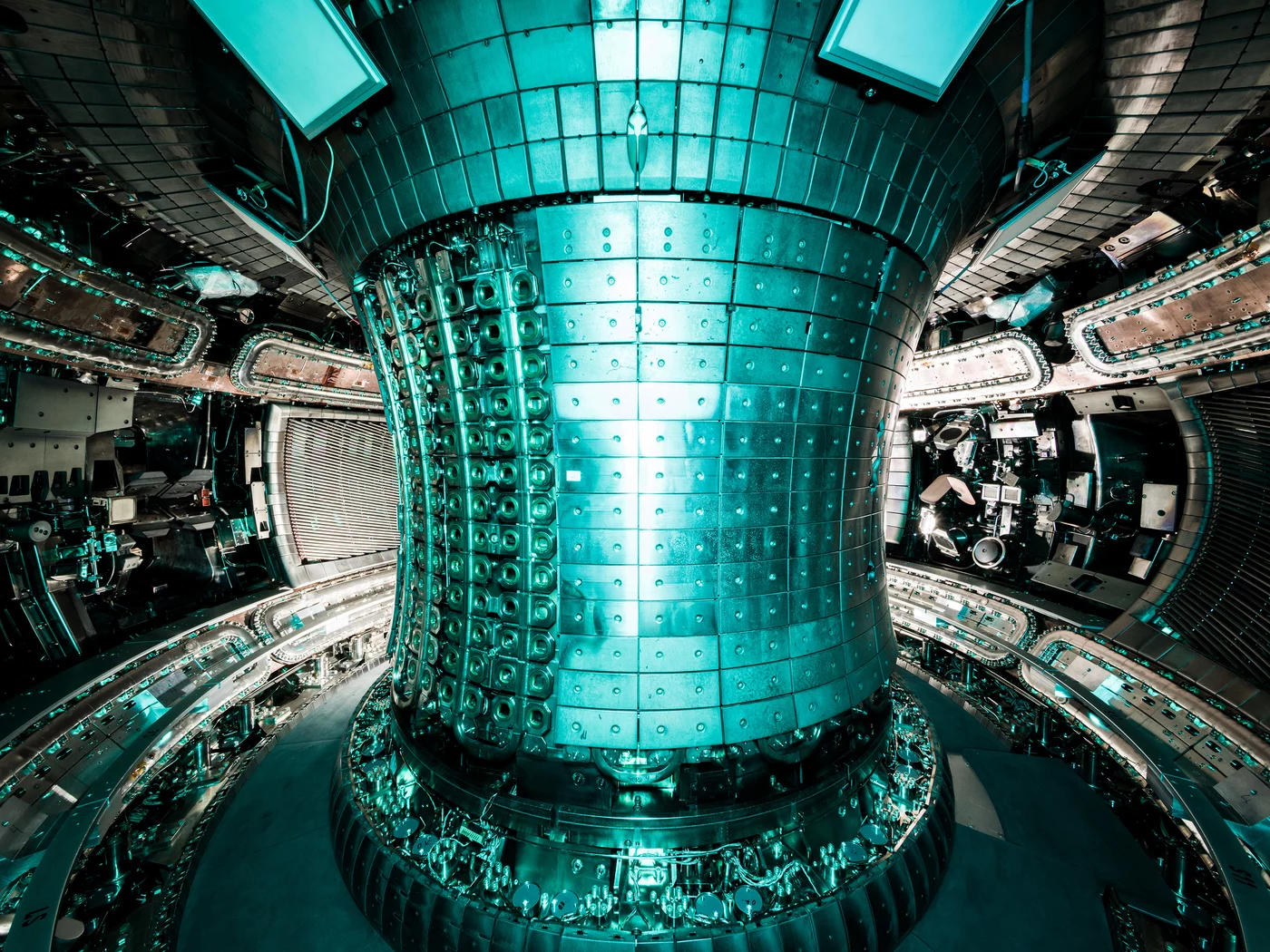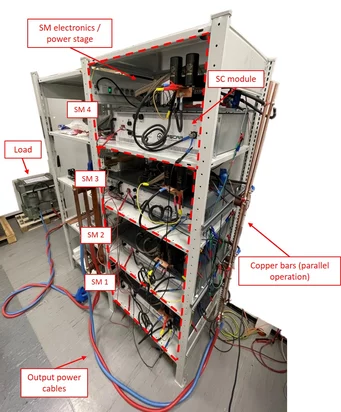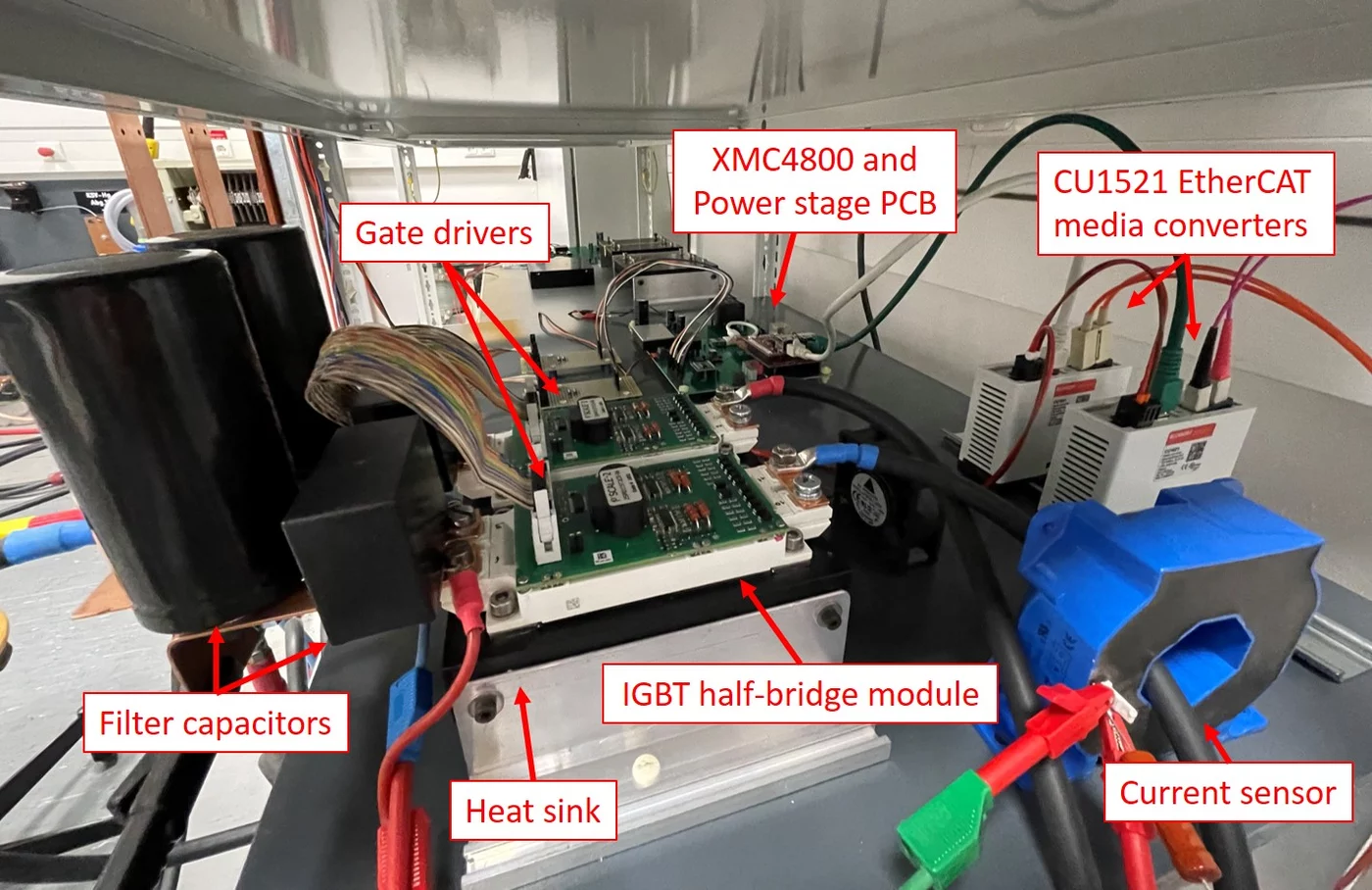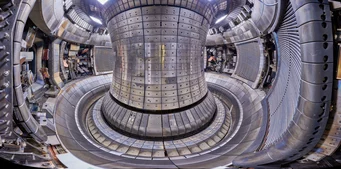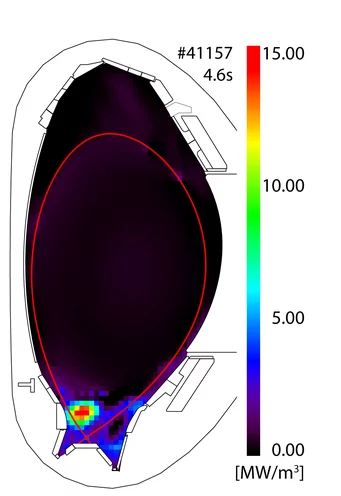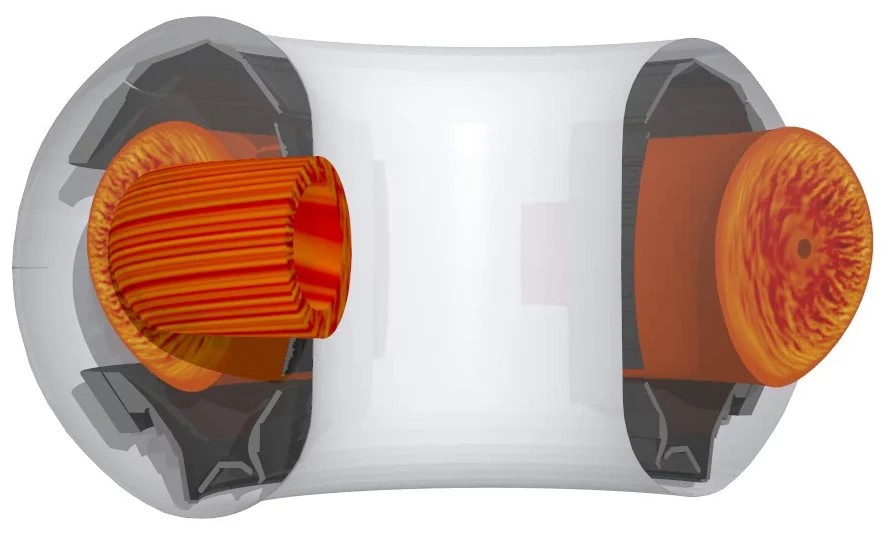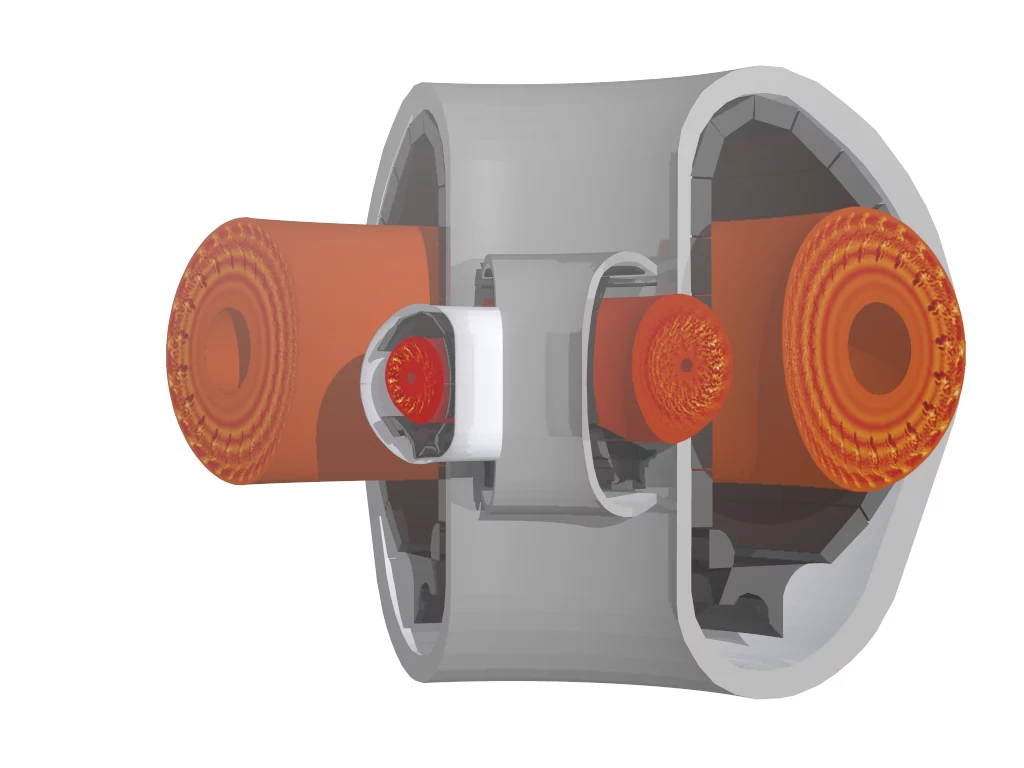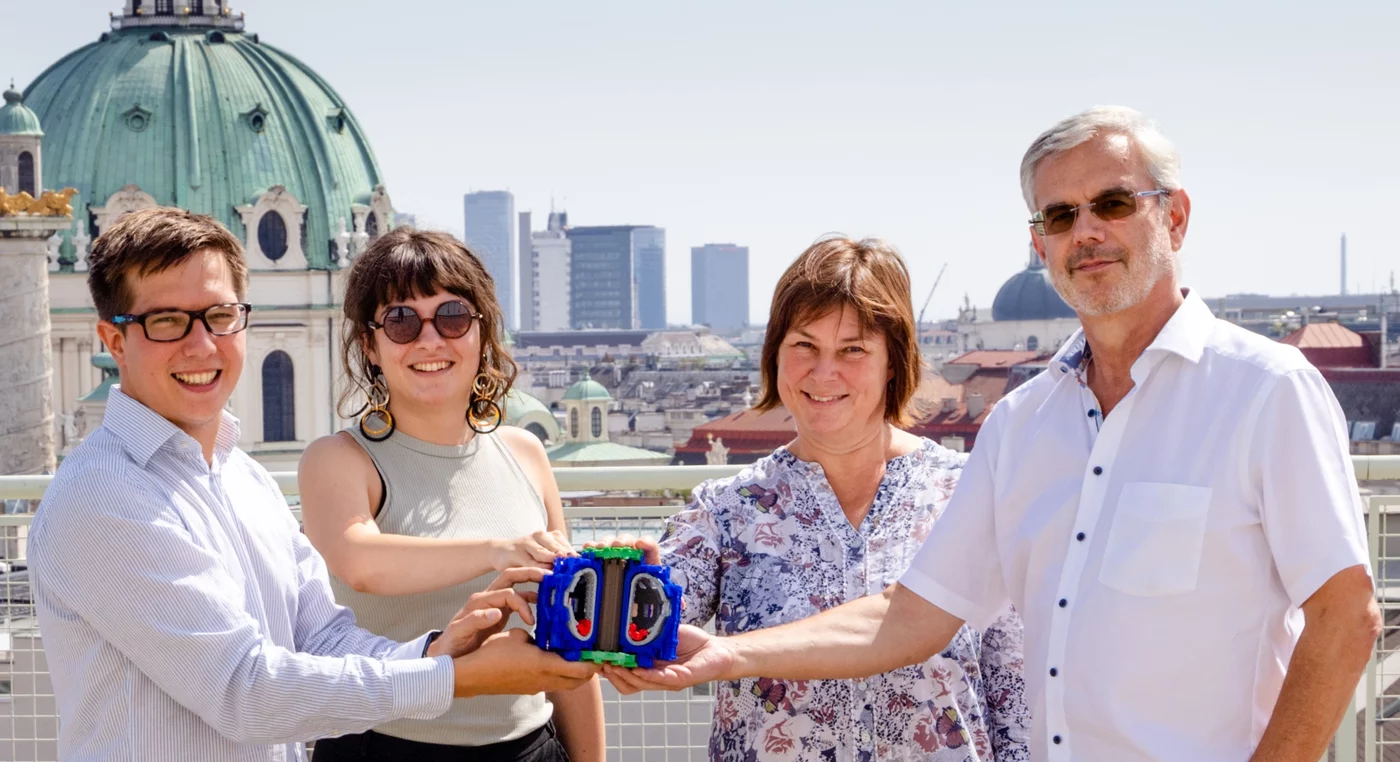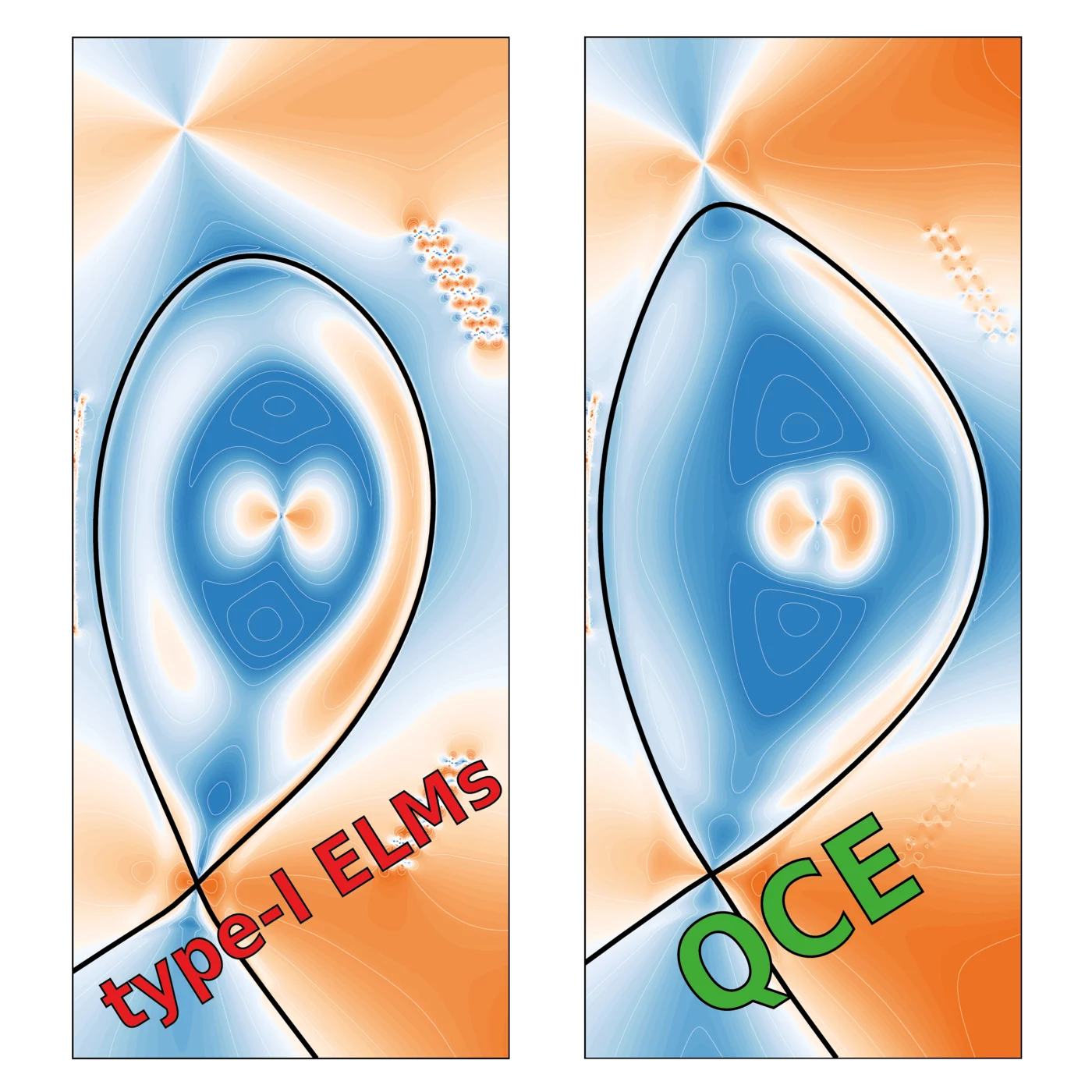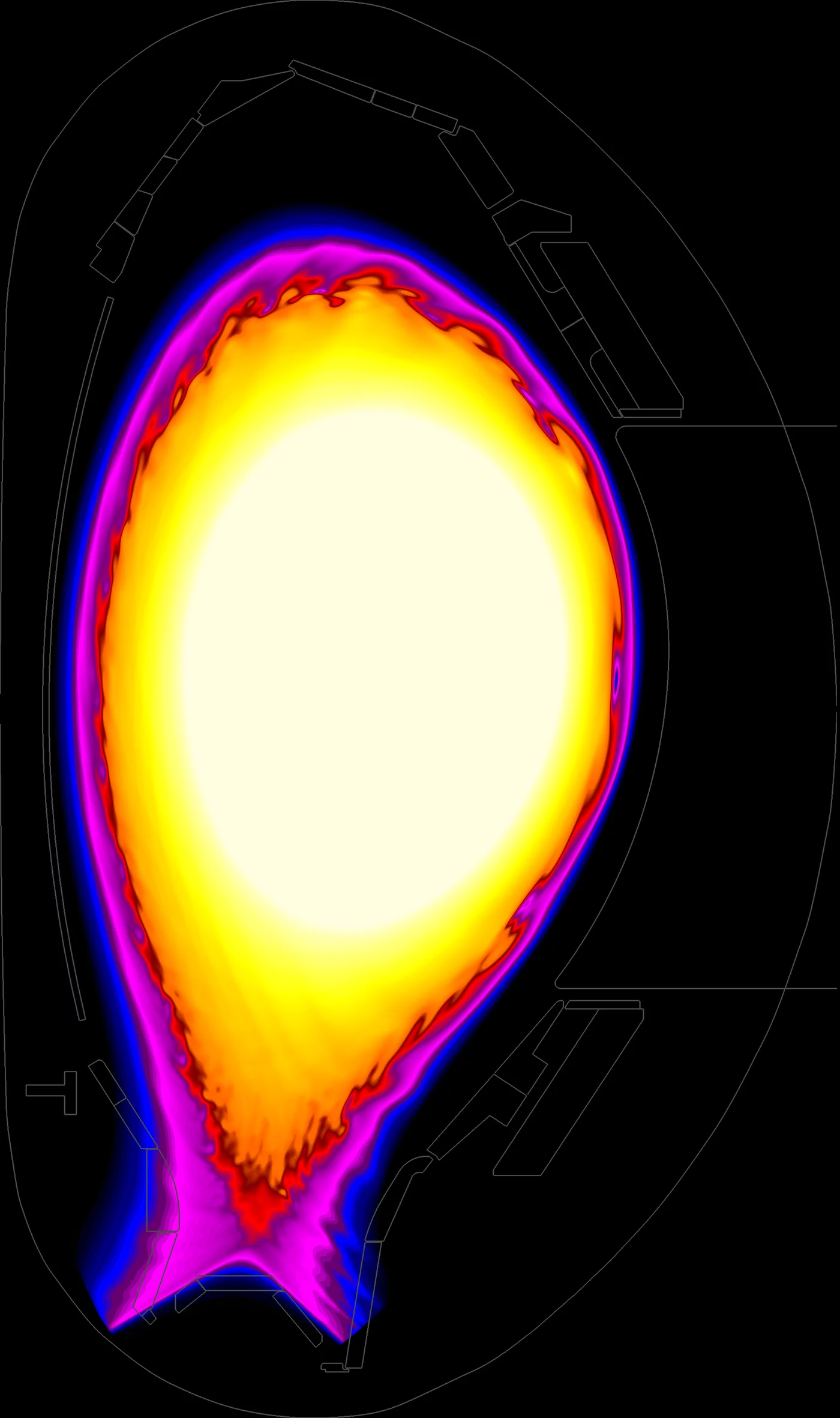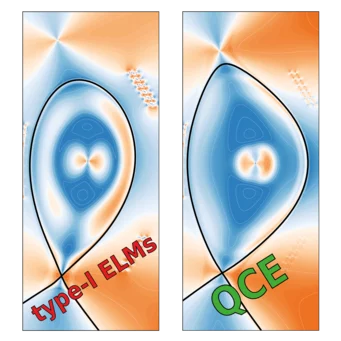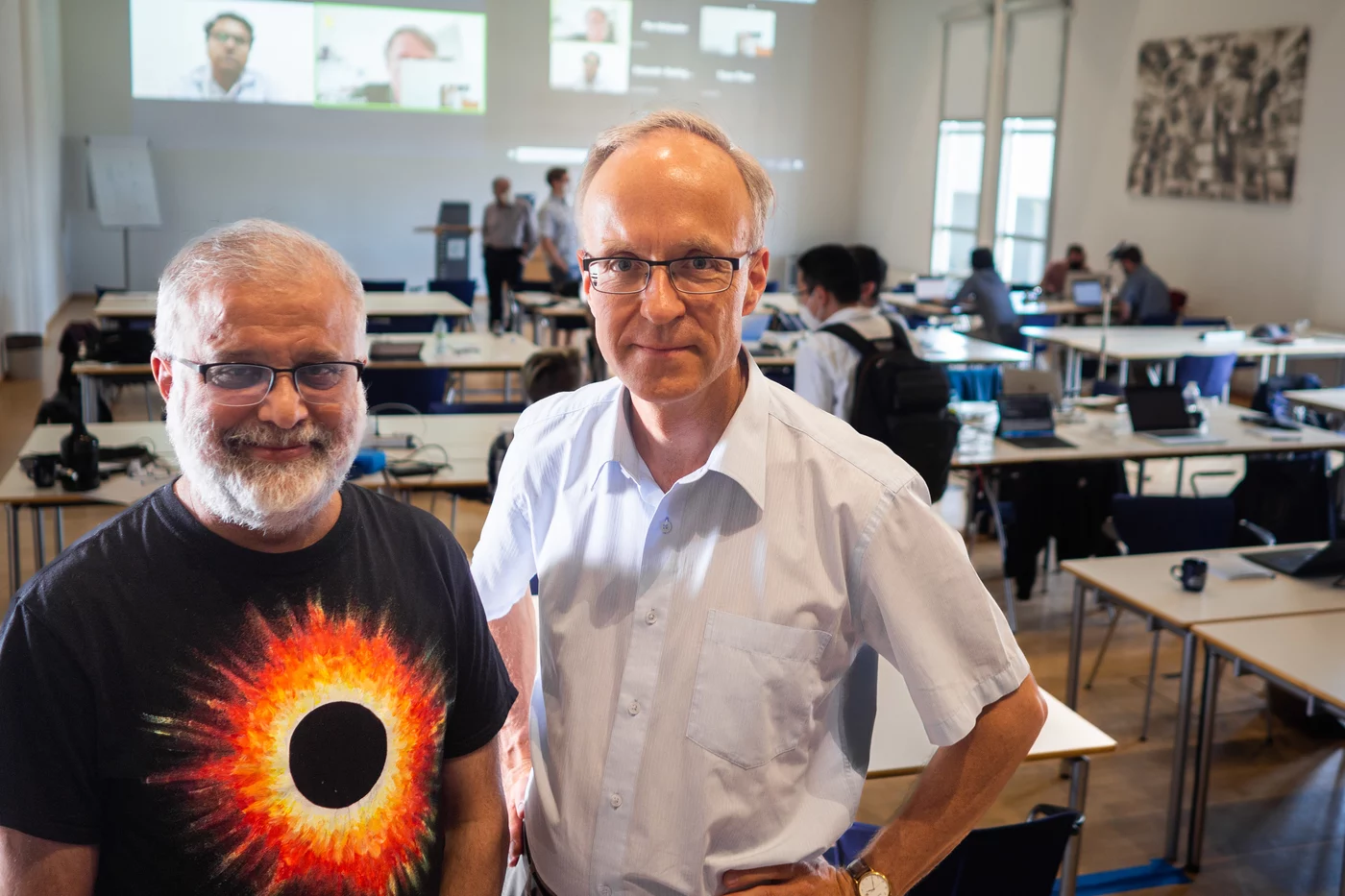From The MPG Institute for Plasma Physics [MPG Institut für Plasmaphysik] (DE)
2.8.24
Frank Fleschner
Press officer
+49 89 3299-1317
press@ipp.mpg.de

At the Joint European Torus (JET) in the UK, a European research team has succeeded in generating 69 megajoules of energy from 0.2 milligrams of fuel. This is the largest amount of energy ever achieved in a fusion experiment.
Fusion power plants are designed to fuse light atomic nuclei, following the example of the sun, in order to harness huge amounts of energy for humanity from very small amounts of fuel. The European research consortium EUROfusion is pursuing the concept of magnetic fusion, which is considered by experts to be the most advanced. With the large-scale experiments ASDEX Upgrade [below] and Wendelstein 7-X [below], the MPG Institute for Plasma Physics (IPP) is driving forward research into this in Germany.
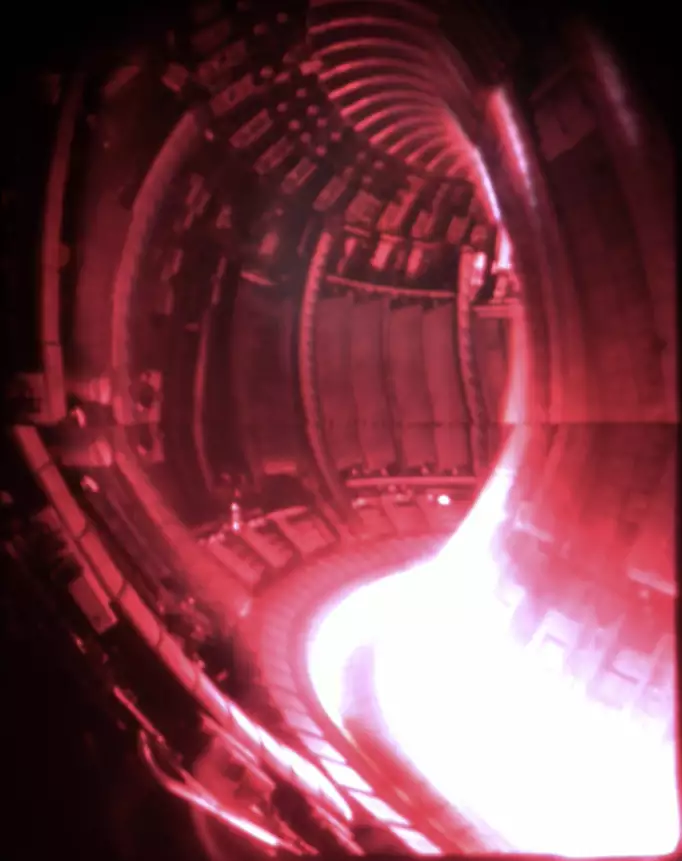
Plasma discharge #104,522: The energy record was achieved in this JET experiment. Photo: UKAEA / EUROfusion.
Fusion power plants are designed to fuse light atomic nuclei, following the example of the sun, in order to harness huge amounts of energy for humanity from very small amounts of fuel. The European research consortium EUROfusion is pursuing the concept of magnetic fusion, which is considered by experts to be the most advanced. With the large-scale experiments ASDEX Upgrade and Wendelstein 7-X, the Max Planck Institute for Plasma Physics (IPP) is driving forward research into this in Germany.
For experiments with the fuel of future power plants (deuterium and tritium), Europe’s scientists operated the JET research facility near Oxford together with the UK Atomic Energy Authority (UKAEA). A new world record was set there on 3 October 2023: 69 megajoules of fusion energy were released in the form of fast neutrons during a 5.2 second plasma discharge. 0.2 milligrams of fuel were required for this. The same amount of energy would have required about 2 kilograms of lignite – ten million times as much. JET thus beat its own record from 2021 (59 megajoules in 5 seconds).
“This world record is actually a by-product. It was not actively planned, but we were hoping for it,” explains IPP scientist Dr Athina Kappatou, who worked for JET as one of nine Task Force Leaders. “This experimental campaign was mainly about achieving the different conditions necessary for a future power plant and thus testing realistic scenarios. One positive aspect, however, was that the experiments from two years ago could also be successfully reproduced and even surpassed.” The latter was the case with the record-breaking experiment. The entire campaign is essential for the future operation of the international fusion plant ITER, which is currently being built in southern France, as well as for the planned European demonstration power plant DEMO. Over 300 scientists and engineers from EUROfusion contributed to these landmark experiments.

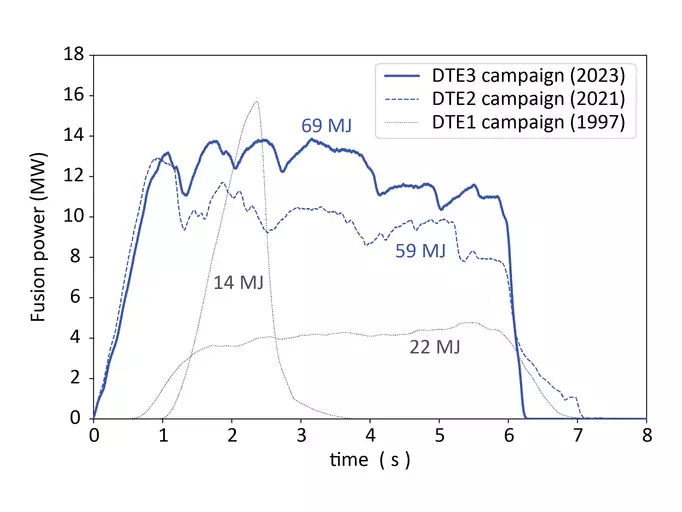
The graph shows the progress of the deuterium-tritium campaigns at JET: in 1997, high power was achieved for a short time, but in the last energy records in 2021 and 2023 it was also possible to maintain this for several seconds. Graphic: UKAEA / EUROfusion.
The JET record did not achieve a positive energy balance – in other words, more heating energy had to be invested in the plasma than fusion energy was generated. In fact, an “energy gain” is physically impossible with JET and all other current magnetic fusion experiments worldwide. For a positive energy balance, these fusion plants must exceed a certain size, which will be the case with ITER.
The record-breaking experiment (JET pulse #104522) in the autumn was one of the last ever at JET. After four decades the facility ceased operations at the end of 2023.
Fusion Energy Record at JET.
See the full article here .
Comments are invited and will be appreciated, especially if the reader finds any errors which I can correct. Use “Reply” near the bottom of the post.

five-ways-keep-your-child-safe-school-shootings
Please help promote STEM in your local schools.
The MPG Institute for Plasma Physics [MPG Institut für Plasmaphysik] (DE) is a physics institute for the investigation of plasma physics, with the aim of working towards fusion power. The institute also works on surface physics, also with focus on problems of fusion power.
The IPP is an institute of the MPG Society, part of the European Atomic Energy Community, and an associated member of the Helmholtz Association.
The IPP has two sites: Garching near Munich (founded 1960) and Greifswald (founded 1994), both in Germany.
It owns several large devices, namely
the experimental tokamak ASDEX Upgrade (in operation since 1991)


It also cooperates with the ITER and JET projects.


MPG Society for the Advancement of Science [MPG Gesellschaft zur Förderung der Wissenschaften e. V.] is a formally independent non-governmental and non-profit association of German research institutes founded in 1911 as the Kaiser Wilhelm Society and renamed the Max Planck Society in 1948 in honor of its former president, theoretical physicist Max Planck. The society is funded by the federal and state governments of Germany as well as other sources.
According to its primary goal, the MPG Society supports fundamental research in the natural, life and social sciences, the arts and humanities in its 83 (as of January 2014) MPG Institutes. The society has a total staff of approximately 17,000 permanent employees, including 5,470 scientists, plus around 4,600 non-tenured scientists and guests. Society budget for 2015 was about €1.7 billion.
The MPG Institutes focus on excellence in research. The MPG Society has a world-leading reputation as a science and technology research organization, with 33 Nobel Prizes awarded to their scientists, and is generally regarded as the foremost basic research organization in Europe and the world. In 2013, the Nature Publishing Index placed the MPG institutes fifth worldwide in terms of research published in Nature journals (after Harvard University, The Massachusetts Institute of Technology, Stanford University and The National Institutes of Health). In terms of total research volume (unweighted by citations or impact), the MPG Society is only outranked by The Chinese Academy of Sciences [中国科学院](CN), The Russian Academy of Sciences [Росси́йская акаде́мия нау́к](RU) and Harvard University. The Thomson Reuters-Science Watch website placed the MPG Society as the second leading research organization worldwide following Harvard University, in terms of the impact of the produced research over science fields.
The MPG Society and its predecessor Kaiser Wilhelm Society hosted several renowned scientists in their fields, including Otto Hahn, Werner Heisenberg, and Albert Einstein.
History
The organization was established in 1911 as the Kaiser Wilhelm Society, or Kaiser-Wilhelm-Gesellschaft (KWG), a non-governmental research organization named for the then German emperor. The KWG was one of the world’s leading research organizations; its board of directors included scientists like Walther Bothe, Peter Debye, Albert Einstein, and Fritz Haber. In 1946, Otto Hahn assumed the position of President of KWG, and in 1948, the society was renamed the MPG Society (MPG) after its former President (1930–37) Max Planck, who died in 1947.
The MPG Society has a world-leading reputation as a science and technology research organization. In 2006, the Times Higher Education Supplement rankings of non-university research institutions (based on international peer review by academics) placed the MPG Society very highly in the world for science research, and very highly in technology research (behind AT&T Corporation and The DOE’s Argonne National Laboratory.
The domain mpg.de attracted at least 1.7 million visitors annually by 2008 according to a Compete.com study.
MPG Institutes and research groups
The MPG Society consists of over 80 research institutes. In addition, the society funds a number of MPG Research Groups (MPRG) and International MPG Research Schools (IMPRS). The purpose of establishing independent research groups at various universities is to strengthen the required networking between universities and institutes of the Max Planck Society.
The research units are primarily located across Europe with a few in South Korea and the U.S. In 2007, the Society established its first non-European centre, with an institute on the Jupiter campus of Florida Atlantic University focusing on neuroscience.
The MPG Institutes operate independently from, though in close cooperation with, the universities, and focus on innovative research which does not fit into the university structure due to their interdisciplinary or transdisciplinary nature or which require resources that cannot be met by the state universities.
Internally, MPG Institutes are organized into research departments headed by directors such that each MPI has several directors, a position roughly comparable to anything from full professor to department head at a university. Other core members include Junior and Senior Research Fellows.
In addition, there are several associated institutes:
International Max Planck Research Schools
International Max Planck Research Schools
Together with the Association of Universities and other Education Institutions in Germany, the MPG Society established numerous International MPG Research Schools (IMPRS) to promote junior scientists:
• Cologne Graduate School of Ageing Research, Cologne
• International Max Planck Research School for Intelligent Systems, at the Max Planck Institute for Intelligent Systems located in Tübingen and Stuttgart
• International Max Planck Research School on Adapting Behavior in a Fundamentally Uncertain World (Uncertainty School), at the Max Planck Institutes for Economics, for Human Development, and/or Research on Collective Goods
• International Max Planck Research School for Analysis, Design and Optimization in Chemical and Biochemical Process Engineering, Magdeburg
• International Max Planck Research School for Astronomy and Cosmic Physics, Heidelberg at the MPI for Astronomy
• International Max Planck Research School for Astrophysics, Garching at the MPI for Astrophysics
• International Max Planck Research School for Complex Surfaces in Material Sciences, Berlin
• International Max Planck Research School for Computer Science, Saarbrücken
• International Max Planck Research School for Earth System Modeling, Hamburg
• International Max Planck Research School for Elementary Particle Physics, Munich, at the MPI for Physics
• International Max Planck Research School for Environmental, Cellular and Molecular Microbiology, Marburg at the Max Planck Institute for Terrestrial Microbiology
• International Max Planck Research School for Evolutionary Biology, Plön at the Max Planck Institute for Evolutionary Biology
• International Max Planck Research School “From Molecules to Organisms”, Tübingen at the Max Planck Institute for Developmental Biology
• International Max Planck Research School for Global Biogeochemical Cycles, Jena at the Max Planck Institute for Biogeochemistry
• International Max Planck Research School on Gravitational Wave Astronomy, Hannover and Potsdam MPI for Gravitational Physics
• International Max Planck Research School for Heart and Lung Research, Bad Nauheim at the Max Planck Institute for Heart and Lung Research
• International Max Planck Research School for Infectious Diseases and Immunity, Berlin at the Max Planck Institute for Infection Biology
• International Max Planck Research School for Language Sciences, Nijmegen
• International Max Planck Research School for Neurosciences, Göttingen
• International Max Planck Research School for Cognitive and Systems Neuroscience, Tübingen
• International Max Planck Research School for Marine Microbiology (MarMic), joint program of the Max Planck Institute for Marine Microbiology in Bremen, the University of Bremen, the Alfred Wegener Institute for Polar and Marine Research in Bremerhaven, and the Jacobs University Bremen
• International Max Planck Research School for Maritime Affairs, Hamburg
• International Max Planck Research School for Molecular and Cellular Biology, Freiburg
• International Max Planck Research School for Molecular and Cellular Life Sciences, Munich
• International Max Planck Research School for Molecular Biology, Göttingen
• International Max Planck Research School for Molecular Cell Biology and Bioengineering, Dresden
• International Max Planck Research School Molecular Biomedicine, program combined with the ‘Graduate Programm Cell Dynamics And Disease’ at the University of Münster and the Max Planck Institute for Molecular Biomedicine
• International Max Planck Research School on Multiscale Bio-Systems, Potsdam
• International Max Planck Research School for Organismal Biology, at the University of Konstanz and the Max Planck Institute for Ornithology
• International Max Planck Research School on Reactive Structure Analysis for Chemical Reactions (IMPRS RECHARGE), Mülheim an der Ruhr, at the Max Planck Institute for Chemical Energy Conversion
• International Max Planck Research School for Science and Technology of Nano-Systems, Halle at Max Planck Institute of Microstructure Physics
• International Max Planck Research School for Solar System Science at the University of Göttingen hosted by MPI for Solar System Research
• International Max Planck Research School for Astronomy and Astrophysics, Bonn, at the MPI for Radio Astronomy (formerly the International Max Planck Research School for Radio and Infrared Astronomy)
• International Max Planck Research School for the Social and Political Constitution of the Economy, Cologne
• International Max Planck Research School for Surface and Interface Engineering in Advanced Materials, Düsseldorf at Max Planck Institute for Iron Research GmbH
• International Max Planck Research School for Ultrafast Imaging and Structural Dynamics, Hamburg
Max Planck Schools
• Max Planck School of Cognition
• Max Planck School Matter to Life
• Max Planck School of Photonics
Max Planck Center
• The Max Planck Centre for Attosecond Science (MPC-AS), POSTECH Pohang
• The Max Planck POSTECH Center for Complex Phase Materials, POSTECH Pohang
Max Planck Institutes
Among others:
• Max Planck Institute for Neurobiology of Behavior – caesar, Bonn
• Max Planck Institute for Aeronomics in Katlenburg-Lindau was renamed to Max Planck Institute for Solar System Research in 2004;
• Max Planck Institute for Biology in Tübingen was closed in 2005;
• Max Planck Institute for Cell Biology in Ladenburg b. Heidelberg was closed in 2003;
• Max Planck Institute for Economics in Jena was renamed to the Max Planck Institute for the Science of Human History in 2014;
• Max Planck Institute for Ionospheric Research in Katlenburg-Lindau was renamed to Max Planck Institute for Aeronomics in 1958;
• Max Planck Institute for Metals Research, Stuttgart
• Max Planck Institute of Oceanic Biology in Wilhelmshaven was renamed to Max Planck Institute of Cell Biology in 1968 and moved to Ladenburg 1977;
• Max Planck Institute for Psychological Research in Munich merged into the Max Planck Institute for Human Cognitive and Brain Sciences in 2004;
• Max Planck Institute for Protein and Leather Research in Regensburg moved to Munich 1957 and was united with the Max Planck Institute for Biochemistry in 1977;
• Max Planck Institute for Virus Research in Tübingen was renamed as Max Planck Institute for Developmental Biology in 1985;
• Max Planck Institute for the Study of the Scientific-Technical World in Starnberg (from 1970 until 1981 (closed)) directed by Carl Friedrich von Weizsäcker and Jürgen Habermas.
• Max Planck Institute for Behavioral Physiology
• Max Planck Institute of Experimental Endocrinology
• Max Planck Institute for Foreign and International Social Law
• Max Planck Institute for Physics and Astrophysics
• Max Planck Research Unit for Enzymology of Protein Folding
• Max Planck Institute for Biology of Ageing


